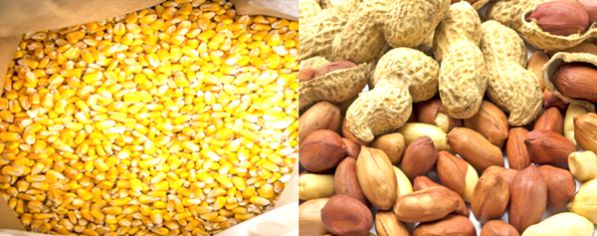
Aflatoxin, cause of malnutrition
Aflatoxins are a group of toxic chemicals produced by fungi, mostly Aspergillus flavus and Aspergillus parasiticus.
There are four major types, namely aflatoxin B1, B2, G1 and G2.
They are originally known for their cancer causing ability, but have recently also been associated with malnutrition.
Malnutrition is a state of poor health which results from the prolonged intake of a diet in which one or more nutrients are either not enough or are too much.
Common types of malnutrition found especially among children in Ghana and other parts of the world are stunting (where a child is too short for his/her age), wasting (where the weight of a child is too low for his/her height), kwashiorkor, marasmus and micronutrient deficiencies like vitamin A, iron, and iodine deficiencies.
Malnutrition can also occur when the body is unable to absorb the nutrients present in the food due to the poor diversity in diet and may result in secondary to an existing disease state or from an intake of unsafe food.
Hot and humid climates, which are mostly found in the tropics, as well as poor cultivation practices promote fungal growth, which infect crops on the field or immediately after harvest and during storage, leading to aflatoxin contamination.
Common crops affected include maize, groundnut, millet, sorghum, wheat and rice. Aflatoxins are also present in legumes such as groundnuts and soybeans.
Aflatoxins
Aflatoxins can gain entry into the human body through the skin, inhalation into the lungs and orally through the gut.
Significant amounts can also be found in human breast milk, cow milk, poultry, eggs, and meat of animals fed with aflatoxin infested products for a long time.
Exposure may start in the early stage of life during childhood breastfeeding, and this may increase after weaning.
Increasing exposure during weaning is because most weaning foods in Ghana and other African countries are prepared from cereal and legume mixes.
Regular consump-tion of foods from the same crop commodity with little variety is known to increase the risk of aflatoxin exposure significantly.
Exposure
Aflatoxin exposure occurs throughout the life course.
Places where the exposure is very high also happen to have high prevalence of malnutrition.
In a study in Ghana, adults with high aflatoxin exposure were likely to be deficient in vitamin A compared to those with low exposure.
In children, up to 35 per cent of stunting is associated with aflatoxin in sub-Saharan African. Maternal blood samples that had higher aflatoxin levels were significantly associated with stunting (low height for age) and wasting (low weight for height) among Gambian children.
Again, evidence from West Africa showed that chronic exposure to aflatoxins in children under five was linked to poor growth (underweight and stunting) and the poor ability to fight invading disease causing micro-organisms.
Long-term aflatoxin exposure has also been linked with kwashiorkor (protein malnutrition). Aflatoxins were detected in high concentrations in children with marasmic kwashiorkor (protein-energy malnutrition) in Nigeria.
Aflatoxin and malnutrition
The process by which aflatoxin may lead to malnutrition is in the poor formation of protein in the body and promoting damage to the intestine.
The intestine is, therefore, unable to absorb essential nutrients, including micro nutrients from food.
Aflatoxin also reduces the amount of nutrients available for absorption from the food we eat.
When this continues over a long period, it results in malnutrition because the body is persistently deprived of nutrient.
Good agricultural practices such as proper weed and disease control, the timely application of agrochemicals to reduce the effect of fungal infection and the cultivation of improved seed variety that are resistant to drought and disease can reduce the prevalence of aflatoxin in food.
Appropriate sorting techniques when gathering farm produce to discard contaminated grains, adequate drying and proper food storage practices must be done under the right conditions to adequately reduce seed moisture which can serve as medium for fungal growth.
In addition, improving the quality of diet by introducing more variety in food can help minimise exposure to aflatoxin.
Livestock and other farm animals must be given high quality feed free from fungal contamination at all times to prevent aflatoxin exposure from consuming their eggs, milk and meat.
Consumers should also carefully inspect grains and nuts when buying from the market or discard discoloured, shrivelled or mouldy ones before cooking.
Food regulatory bodies should also ensure that the grains and legumes on the market are of good quality.
The writers are with the Department of Nutrition and Dietetics
School of Biomedical and Allied Health Sciences
University of Ghana
Korle Bu-Accra.